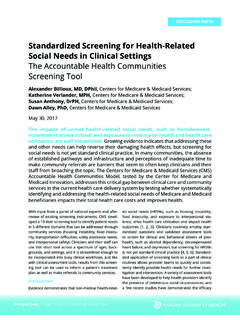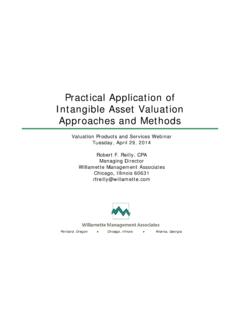Transcription of Practical guide - Health and Safety Executive
1 work - related Deaths protocol : Practical guide (England and Wales) Signatories to the work - related death protocol National Police Chiefs Council (NPCC) - NPCC brings together the expertise and experience of chief police officers from the UK, providing a professional forum to help deliver effective policing. work - related deaths - the police will assume primacy for the investigation until any suspicion of a homicide related offence is discounted. In all cases the police will work in partnership with other investigating & enforcement agencies. British Transport Police (BTP) - BTP has responsibility for investigating all deaths on the Railway infrastructure and where appropriate will submit files to the CPS to consider criminal charges for offences of Murder, Manslaughter and Corporate Manslaughter.
2 BTP work closely with partners such as Office of Railway Regulation (ORR) and Rail Accident Investigation Branch (RAIB) to establish primacy for incidents and ensure relevant matters are investigated. Chief Fire Officers Association (CFOA) - In England and Wales, Fire and Rescue Authorities are responsible for enforcing the Regulatory Reform (Fire Safety ) Order 2005 in all premises with the exception of premises that are comprised in a house which is occupied as a single private dwelling. Some Authorities also enforce explosives and petroleum licensing requirements. Crown Prosecution Service (CPS) - CPS is the principal prosecuting authority for England and Wales and has responsibility for prosecuting all criminal charges resulting from work - related deaths, except cases where the only charges to be pursued are under the Health and Safety at work etc. Act. The CPS will only prosecute those cases in exceptional circumstances.
3 Care Quality Commission (CQC) - CQC is the independent Health and social care regulator in England. We regulate the provision of Health and social care services by those registered with CQC and prosecute unregistered providers. Care and Social Services Inspectorate Wales (CSSIW) - CSSIW is the independent inspectorate and regulator for social care in Wales. We regulate child care and social care providers who are registered with CSSIW and take enforcement action against unregistered providers. Health and Safety Executive (HSE) - HSE enforces the Health and Safety at work etc. Act 1974 in a range of sectors, including general manufacturing, construction, domestic gas Safety , agriculture, public services & quarries, onshore major hazards (including mines, explosives, biological agents, chemical & petrochemical manufacturing) and offshore major hazards (including oil & gas installations).
4 Local Government Association (LGA) - Local Authorities in England enforce the Health and Safety at work etc. Act 1974 which covers a diverse range of work activities and workplaces that have different levels of Health and Safety risk in a range of sectors, including retail, offices, wholesale / retail warehouses, hospitality & leisure (including hotels, camp sites, restaurants, night clubs, cinemas, social clubs, sports facilities, racecourses, pleasure boat hire, museums, theatres, art galleries), places of worship, undertakers, animal care, therapeutic & beauty services, care homes and private pre-school child care. Maritime and Coastguard Agency (MCA) - The Maritime and Coastguard Agency (MCA) is responsible for the, regulation and enforcement of Safety standards in all shipping sectors. The Agency covers UK vessels anywhere in the world and foreign registered vessels when within UK waters.
5 MCA prosecutea on behalf of the secretary of state for Transport. MHRA Medical Devices Division - The MHRA is the UK regulatory authority for medicines and medical devices. The Devices Division investigates all reported incidents involving medical devices used in hospitals, primary care and social care settings. We work closely with the HSE, the Police and Coroners in cases involving patient deaths, as appropriate. Office for Nuclear Regulation (ONR) - ONR is responsible for regulating Health and Safety on GB Nuclear sites, Authorised Defence sites, Nuclear Warship sites, and Nuclear New Build. ONR is responsible for the investigation of work related Deaths which may occur at those sites. Office of Rail Regulation (ORR) - ORR is the independent Safety and economic regulator for Britain's railways. We regulate Health and Safety for the entire mainline rail network in Britain, as well as London Underground, light rail, trams and the heritage sector.
6 Welsh Local Government Association Local Authorities in Wales enforce the Health and Safety at work etc. Act 1974 in the same range of sectors as in England (see Local Government Association for detail). Foreword The work - related Deaths protocol expects joint investigation of deaths in the workplace. The purpose of this Practical guide is to assist the police, enforcing authorities and prosecutors in the joint investigation and where applicable, the prosecution of cases in relation to deaths in the workplace. It is intended to be read in conjunction with the work - related deaths: A protocol for liaison document from which the core of the Practical guide has been drawn. This Practical guide is not mandatory but gives Practical guidance on the principles of liaison and joint investigation advocated by the protocol . This guide is not a training document. It has been prepared on the assumption that those tasked with investigating such serious and tragic matters, from whichever organisation, are qualified to do so.
7 It provides a straightforward approach to the joint investigation of deaths within the workplace. The guide , and the protocol , promote liaison with colleagues from other enforcing authorities, and advocates that such liaison is not left to chance or to the discretion of the individuals involved. This guide also provides an event-driven timetable with liaison issues pertinent to each event. The Appendices contain checklists of actions to be taken by the first officer at the scene, the supervisory officer and the senior investigating officer (SIO). In preparing the Practical guide , attention has been paid to the legislation that impacts upon all criminal investigations. It also takes account of the specific guidance provided to Police from ACPO manuals, including those dealing with homicide, road deaths and the Human Rights Act 1998. Equal account has also been taken of the Health and Safety Executive s operating policies, which are mirrored in guidance issued to other local authority agencies.
8 The guide applies to all work - related deaths including deaths within the signatory organisations. Police officers should be aware that in addition to conducting a criminal investigation for the purpose of ascertaining whether a person (or company/ organisation) should be charged with a serious criminal offence (other than a Health and Safety offence), the relevant enforcing authority1 has a responsibility to ensure dutyholders (who may also be suspects) take immediate action to deal with serious risks, and to promote and achieve sustained compliance with the law. 1 A relevant enforcing authority means the Health and Safety regulator with responsibility for the activity or workplace involved and includes HSE, ORR, local authorities, MCA and the Fire and Rescue Services. Introduction This Practical guide commences with a contents page, which seeks to encapsulate the protocol on one page.
9 This allows investigators to consider their actions within the context of the protocol , and to navigate to the applicable section of the guidance. The appendices to this guide list actions to be taken by the first officer at the scene, the supervisory officer and the senior investigating officer (SIO). This guide was first published on the HSE website as the Investigators guide in March 2004 and updated in September 2011 and May 2012. It was reviewed by the National Liaison Committee on the work - related Deaths protocol (NLC) in 2014, re-named Practical guide and published in February 2015. The guide is intended to be a living document, that is, it can be updated and revised by the NLC as necessary. Practical guide Contents Section Title Page 1. Determining whether the incident is a work - related death ? 6 2. Initial Action. 7 3.
10 Management of Investigation. 8 4. Decision Making. 11 5. Disclosure of Material. 13 6. Special Inquiries. 14 7. Advice prior to Charge. 16 8. Decision to Prosecute. 17 9. The Prosecution. 19 10. HM Coroner. 20 11. National Liaison. 23 12. Local Liaison. 23 Appendix 1: Duties of First Officer. 25 Appendix 2: Duties of Supervisory Police Officer. 29 Appendix 3: Duties of Investigating Officer (SIO). 31 Appendix 4: Special Considerations. 33 Appendix 5: Where Police Have Primacy. 34 1. Determining whether the incident is a work - related death A work - related death is a fatality resulting from an incident arising out of, or in connection with, work . The protocol and associated guidance also apply to cases where the victim suffers injuries that are so serious that there is a clear indication, according to medical opinion, of a strong likelihood of death .















